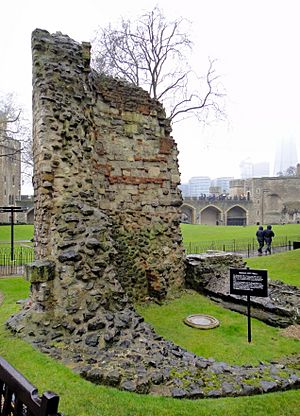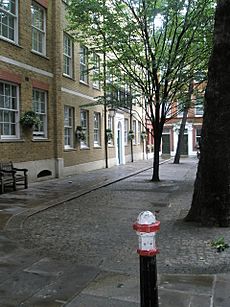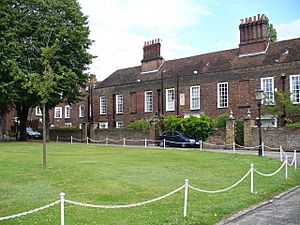Wardrobe (government) facts for kids
The King's Wardrobe was an important part of the English government during the Middle Ages. Think of it as a special office that handled the king's personal belongings, money, and even military supplies. It started as a room where the king kept his clothes, armor, and treasures. Over time, it grew into a powerful department with many clerks (officials) who managed its operations.
For a while, in the 1200s and 1300s, the Wardrobe became very influential. It received money from the main treasury, called the Exchequer. The gold and jewels stored in the Wardrobe also allowed the king to pay for secret missions, diplomacy, and wars quickly. Because of this, it sometimes became even more important than the Exchequer for spending money.
There were actually two main types of Wardrobes. Around 1300, the Great Wardrobe separated from the main one. The Great Wardrobe focused on buying and storing things like clothing, fabrics, furs, and spices. The original, more important Wardrobe continued to handle the king's personal spending and military costs. There were also smaller Privy Wardrobes in royal palaces. The one at the Tower of London became very important for storing and making armor and weapons.
By the 1400s, the Wardrobe lost much of its power and eventually became part of the larger royal household. The Great Wardrobe then took on the name "the Wardrobe" for a while. However, it also lost its independence later and was finally closed down in 1782.
Contents
The King's Household Wardrobe
How the Wardrobe Started
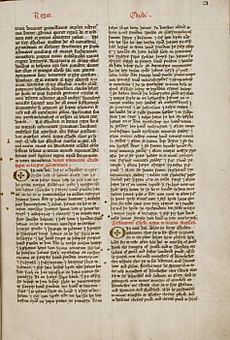
In the Middle Ages, rich and powerful people often had a special room called a "chamber" where they slept. Next to it, they would have a secure "wardrobe" room (garderoba) to keep clothes and other valuable items safe. In the king's household, the Chamber was where the king's closest advisors worked.
Soon, the Wardrobe grew out of the Chamber. It became its own administrative body. It was responsible for safely storing the king's robes, treasures, important documents, and weapons. Like other parts of the royal household, the Wardrobe traveled with the king. Carts and cases full of valuables moved with the king and his court as they traveled around the country.
Before the 1200s, there isn't much information about the Wardrobe. But by the time of King Henry II, the king's Wardrobe was known as a "safe place" with its own staff and rooms in royal palaces. However, the Chamber and the Wardrobe still shared many duties.
The Wardrobe Becomes More Powerful
After 1200, the Wardrobe became much more active and important. This was partly because King John traveled constantly. He needed a quicker way to get money than the main treasury, the Exchequer. The Wardrobe soon became a rival to the Chamber in terms of power. It even became more important in governing the country.
For example, during the early rule of King Henry III, the job of "Treasurer of the Chamber" was taken over by the "Keeper of the Wardrobe." Around the same time, the Keeper's assistant, the "Controller of the Wardrobe," was given control of the Privy Seal. This was a special seal used for important documents. This meant the Wardrobe not only stored important papers but also started creating them. From then on, the Controller was often a trusted advisor to the king. A third official, the "Cofferer of the Wardrobe," began to handle the daily tasks of the Wardrobe.
Historians believe the Wardrobe grew in power because it was "new and flexible." It wasn't stuck in old traditions. It could respond quickly when money was needed fast, especially during wars. It did this by getting loans from Italian bankers, using its valuable treasures as security. This made the Wardrobe a very strong financial office on its own.
There was also a political reason for the Wardrobe's rise. If powerful nobles controlled one government office, the king could still rule through the Wardrobe. This is why nobles in 1258 demanded that all money should go through the Exchequer instead.
During the reign of King Edward I, the Wardrobe was at its most powerful. It was the "brain and hand of the Court." Its seal, the Privy Seal, was no longer just the king's personal seal. It became a second, less formal, state seal, used alongside the Great Seal of the Realm. The Privy Seal often traveled with the king, making it faster to use than the Great Seal, which stayed with the Chancellor. Officials across the kingdom received instructions using this seal. Even the Exchequer and the Chancery (two main government offices) got orders from the Wardrobe. Soldiers were paid through the Wardrobe's accounts. The Keeper or Treasurer of the Wardrobe was considered one of the two most important officers in the Household.
The Wardrobe still traveled with the king, but it had two permanent "Treasuries." One was in the Tower of London (which later became the Great Wardrobe). The other was in the crypt of Westminster Abbey. The Abbey treasury held most of the royal jewels, gold, and silver throughout the 1200s. But after a robbery in 1303, most of the remaining treasure was moved to the Tower. This included items like the coronation regalia, which are still kept at the Tower today.
The Wardrobe's Power Decreases
Towards the end of Edward I's rule, expensive wars weakened the Wardrobe's independent finances. Then, during the reign of King Edward II, efforts were made to bring power back to the Chancery and the Exchequer. They wanted to limit the Wardrobe's authority.
For example, in 1307, a separate Keeper of the Privy Seal was appointed. Over the next few decades, the Privy Seal became a minor state office, working outside the Wardrobe. In 1311, a series of rules called the Ordinances of 1311 were issued by nobles who opposed the king. These rules tried to reverse the Wardrobe's new powers. For instance, rule 8 said that only the Exchequer should receive taxes and other state money. Later, under King Edward III, any arguments about the Wardrobe's authority were settled. William Edington, the Treasurer in the mid-1300s, made reforms that put the Wardrobe firmly under the Exchequer's financial control.
Around this time, the Wardrobe began to be called the Household Wardrobe. This helped tell it apart from the growing "Great Wardrobe." It also showed that the Wardrobe was losing its wider influence. In England, its work was now limited to managing the Household. Even when the king traveled overseas, the Wardrobe only acted as a helper to the Exchequer. During wars, it still provided funds but under the Exchequer's authority. This was different from earlier times when it acted as an independent "war treasury." The Battle of Crécy was one of the last times the Wardrobe provided significant funds for a military campaign on its own.
With the Wardrobe under more control, the king started to use the Chamber again for his personal administration and finances. This is where the idea of a "privy purse" (the king's private money) began under Edward II. The king also started using a "secret seal" for personal letters instead of the Privy Seal. Under Edward II and Edward III, the chief Chamberlain became a very influential person in the Household again.
By the time of King Richard II, the Chamber was the most important part of the Household. The Wardrobe then "stopped being the main driving force of the household." It became simply the office that handled household accounts. Instead of being a separate department, the Wardrobe and its officers now reported to the Steward. Soon, even within the Household, the Wardrobe began to lose its separate identity. By the late 1300s, its senior officers were often called the Treasurer of the Household, Controller of the Household, and Cofferer of the Household. Despite the Wardrobe's decline, these three officers remained (and two still remain) as important members of the Household and the Government. In the 1400s, during conflicts, the Treasurer of the Household was often also called the "Treasurer of Wars," showing a small reminder of the Wardrobe's past importance.
Main Officers of the Household Wardrobe
Keeper or Treasurer of the Wardrobe
The main officer of the Wardrobe was first called the Clerk of the Wardrobe. This person oversaw a small team of workers who handled carts, horses, and goods. As the Wardrobe grew, more clerks (who were skilled administrators) were hired. The chief official then became known as the Keeper of the Wardrobe. From 1232, the job of "Treasurer of the Chamber" was combined with the Keeper's role. So, the terms Keeper, Treasurer, and Clerk were used almost the same way. But during Edward II's reign, Treasurer of the Wardrobe became the most common title. This officer was in charge of the king's expenses, received all money, jewels, and gifts, and kept daily records of all household transactions.
Controller of the Wardrobe
The main job of the Controller of the Wardrobe was to check and control the Keeper/Treasurer's spending. They did this by keeping a second set of accounts. This officer also made sure that different household departments followed financial rules and maintained quality. The office started in the 1230s. The Controller also managed the Wardrobe's collection of important state documents. This gave the office a secretarial role. Under Edward I, the Controller was in charge of the Privy Seal and acted as the king's private secretary. Their small team of clerks played a key role in overseeing the entire Household. By the end of Edward III's reign, this important court official was known as the Controller of the Household.
Cofferer of the Wardrobe
The job of Cofferer of the Wardrobe began in the late 1200s. This was when the Treasurer/Keeper's main clerk took on the special task of preparing the Wardrobe accounts. The Cofferer worked closely with the Treasurer and often acted as the working head of the Wardrobe when the Treasurer was busy with other state matters. In their own right, the Cofferer managed a small accounting office. Their clerks played a key role in overseeing the Household's finances.
The Great Wardrobe Emerges
During the 1200s, a separate part of the Wardrobe began to appear. It was called the Great Wardrobe. The word "Great" might have referred to the size of the items it stored, not necessarily its importance.
What the Great Wardrobe Did
The Great Wardrobe handled many different goods. These included cloth, tapestries, clothing, furniture, sugar, spices, and dried fruit. Later, it also stored and even made jewelry, tents, saddles, armor, and other military items. All these items had one thing in common: they didn't spoil easily and could be stored for a long time. The Great Wardrobe started as the part of the King's Wardrobe that mainly stored these items when the traveling court didn't need them right away. From early on, it was special because it hired city merchants and skilled craftspeople. These experts knew more about these goods than the regular Wardrobe clerks.
Setting Up in the 1200s
The name "Great Wardrobe" (magna garderoba) first appeared in 1253. By this time, the older Wardrobe had become a complex office for managing money and government. Its staff had less time for daily storekeeping. However, storing goods was still necessary because the Wardrobe, like the rest of the royal household, traveled with the king. It carried all the goods it was responsible for. It made sense to keep some of these items in a more fixed location.
The "Great Wardrobe" was the name given to this more centralized storage system. At first, there wasn't just one Great Wardrobe location. Most items were stored in the Tower of London, as London was a good place for distribution. But other items were stored elsewhere, depending on where they might be needed. Several palaces and castles had their own Great Wardrobe storerooms. Some of these were for specific items, located near where those items were made or traded.
Throughout the 1200s, the Great Wardrobe remained a smaller part of the main Wardrobe. Even with moves towards more central storage, the Great Wardrobe officers still traveled with the Court. If the king was staying in a place for a long time, or if he was fighting a war, many Great Wardrobe items had to be transported with him in long lines of wagons.
Changes in the 1300s
By the 1300s, the Great Wardrobe also started making things, not just buying, storing, and distributing goods. It employed the King's Tailor, Armourer, and other skilled workers. However, it was still a sub-department of the Household Wardrobe until 1324. Then, it gained more independence by reporting directly to the Exchequer instead of the Household Wardrobe. It also started traveling less with the king's court and began to set up permanent locations outside the Tower in the City of London. Its staff often dealt with city merchants. This move was partly due to a lack of space. The Tower was becoming a special place for storing and making arms and armor. This responsibility soon went to a new branch, the Privy Wardrobe.
Arms and armor, along with royal jewels, stayed at the Tower. But many other items were moved out. From around 1300, the Great Wardrobe began renting properties in the City for extra storage and office space. It used several places, including in Bassishaw and Lombard Street, while still keeping a presence in the Tower. Then, in 1362, it got a more suitable property, which became known as The Wardrobe. This mansion provided storage, offices, meeting rooms, and living quarters for staff. It also had space for several small workshops. The nearby church is still called St Andrew-by-the-Wardrobe. With its permanent headquarters, the Great Wardrobe became less a part of the King's Household and more "a small, self-contained government office."
Keepers and Masters of the Great Wardrobe
Early on, certain people were known as "buyers" or "purveyors" within the King's Wardrobe. They kept their own accounts. Often, the King's tailor had this job, which involved buying silk, cloth, and furs for robes. A rule in 1279 made this official. It said the Treasurer (Keeper) of the Wardrobe should appoint a person to buy all items for the Great Wardrobe, and this person would be the Keeper of the Great Wardrobe. By the 1500s, the department was very independent, and its keeper began to be called the Master of the Great Wardrobe.
The Privy Wardrobe Emerges
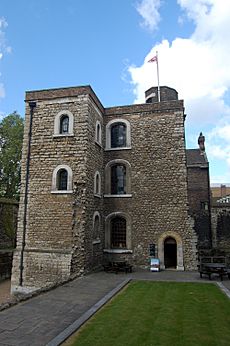
The term Privy Wardrobe (parva garderoba) is mentioned from the 1220s onwards. At first, it seemed to mean a room used to store the King's robes, armor, and weapons. By the late 1200s, the same phrase clearly referred to a small organization led by a Clerk. This group would travel with the Court and provide the king with these personal items. This traveling Privy Wardrobe continued to serve the king on his journeys, even when the Court itself stopped moving around so much. It was later known as the Removing Wardrobe.
However, the central Privy Wardrobe at the Tower of London became very important. It became the main official place for storing and providing arms, armor, and artillery for the Kingdom of England.
The Privy Wardrobe at the Tower Becomes Specialized
By the 1300s, the Tower of London was well-known as a safe place to store arms, armor, jewels, and plate. So, when the Great Wardrobe moved out, these items stayed. Weapons had been made inside the Tower since the 1200s. The local Wardrobe staff had valuable experience, and the Tower was in a good location for quick distribution. Even in the 1330s, before the Great Wardrobe left, the local "Privy Wardrobe at the Tower" began to specialize in this work. After 1361, it also gained some financial and administrative independence. It reported directly to the Exchequer instead of the royal household. In the mid-1400s, it was replaced by the Office of Armoury and the Office of Ordnance (both also based at the Tower). After this, the Privy Wardrobe's funding stopped, and it largely lost its influence, though it continued to have a small role until the late 1400s.
Keepers of the Privy Wardrobe
In July 1323, John Fleet was appointed "Keeper of the part of the King's Wardrobe in the Tower of London." This was the first such appointment and marked a key step in the Privy Wardrobe there becoming a place for storing and making arms, armor, and artillery.
Other Wardrobes
Other members of the Royal Family had their own separate wardrobes. These were also departments with clerks, similar to the King's Wardrobe. The first known Queen's Wardrobe belonged to Eleanor of Provence (wife of King Henry III). Her Wardrobe was quite independent and reported directly to the Exchequer. Later Queens' Wardrobes were usually smaller parts of the King's Wardrobe. A Prince's Wardrobe was set up for Edward of Caernarfon (who became Edward II) and for other royal children over the years.
Also, many nobles, bishops, and other important people had their own personal Wardrobes from the 1200s to the 1400s. Some of their wardrobe accounts show that they spent as much on their households (and military) as the royal family did.
In the late 1300s, when the King's court moved around less, several small, separate Wardrobes were set up in castles or palaces used by the Royal Family. Each had its own keeper. An inventory from the 1500s, during the reign of King Edward VI, lists thirteen such local wardrobes. It also mentions a distinct "Wardrobe of Robes," the Removing Wardrobe (which was the traveling Privy Wardrobe), and the still-existing Great Wardrobe.
|


